Setting Up Payment and Payment Plans
Set up payment
Log in to your website if you are not already logged in, and go to the WordPress administration dashboard.
Click Directories in the admin sidebar.
Under the Settings tab, click the Payment sub-tab. Scroll down to the General Settings section and select a payment component from the Payment component dropdown.
Default - The built-in payment gateway component of Directories Pro. Stripe and PayPal payment gateways are available.
WooCommerce - Uses the WooCommerce plugin. See this page for all available payment gateways. Make sure the WooCommerce plugin is already installed and set up by following the WooCommerce Setup Wizard.
Additional settings are available depending on the payment component selected in step 3.
Default
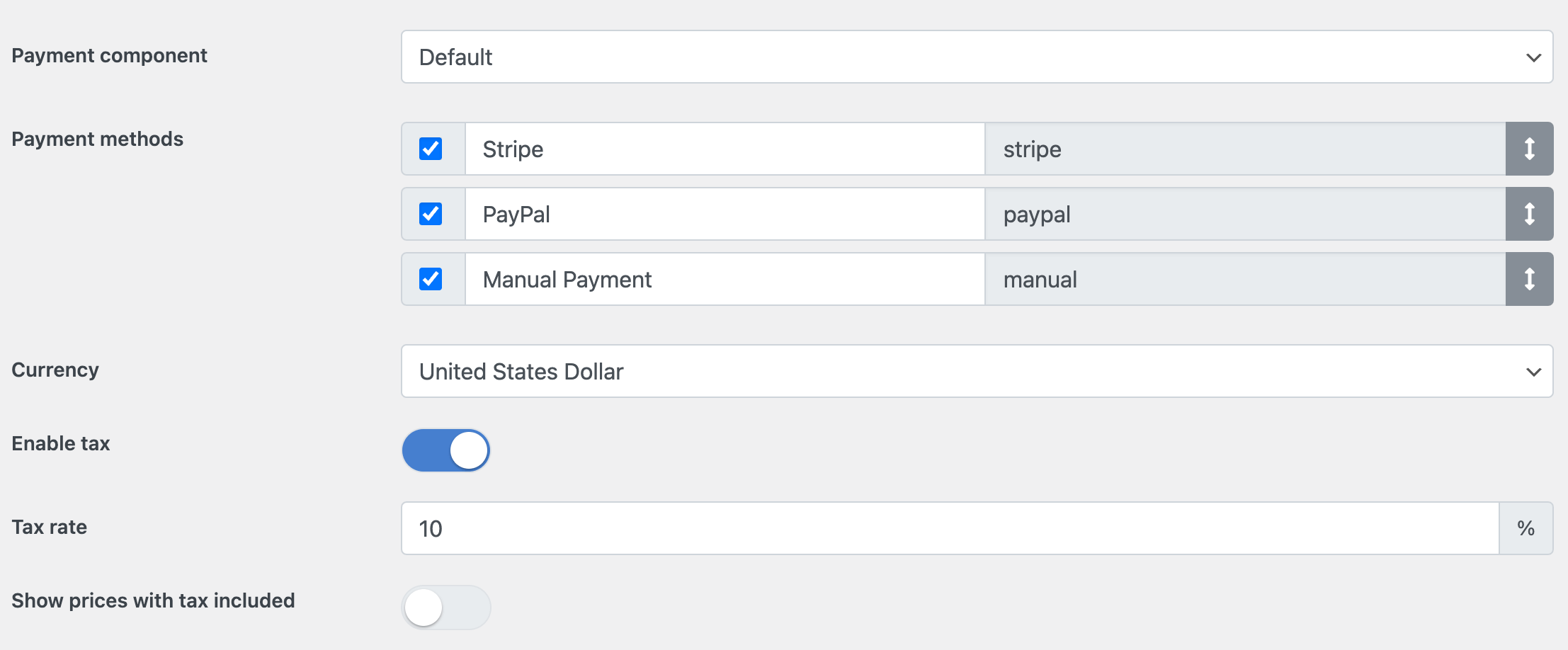
- Payment methods - Choose the payment methods you wish to enable.
- Currency - Select the currency used for payments.
- Enable tax - Whether to add tax to the price.
- Tax rate - Enter the tax rate.
Show prices with tax included - Whether to include tax in the displayed price.
In addition, depending on the payment methods selected, configure API (Stripe and/or PayPal) and extra feature settings for each payment method.
WooCommerce

- Skip cart page - Whether to skip the cart page and go straight to the checkout page during the payment process.
Enable payments for your directory
Follow these steps to enable payments for your directory:
Log in to your website if you are not already logged in, and go to the WordPress administration dashboard.
Click Directories in the admin sidebar.
Under the All Directories tab, click the gear icon in the row of the directory you want to edit.
Under the Settings tab, scroll down the page and select Yes for Enable payments.

Scroll further down and click Save Changes.
Payment plans
There are three types of payment plans in Directories Pro:
Base plans - Base plans define the base features that should be enabled for listings associated with the plans. A listing may not have multiple base plans associated at the same time. Base plans can be purchased when users submit new listings, claim existing listings, renew their listings, or upgrade/downgrade their listings.
Subscription plans - Subscription-based recurring payment plans, which are essentially base payment plans with automatic billing capability. You can charge users for posting their listings on a weekly, monthly, or yearly basis.
Add-on plans - Add-on plans provide additional features to listings on top of the features provided by a base or subscription plan. A listing must already have a base or subscription plan associated in order to have add-on plans applied. There is no limit to how many add-on plans can be purchased for a single listing.
Adding payment plans
If you are using the Default payment component, follow the steps below to create payment plans.
Adding a Base plan
Log in to your website if you are not already logged in, go to the WordPress administration dashboard.
Click Payment Plans under your directory menu in the admin sidebar.
Click the Add Payment Plan button.
Enter the title of the payment plan. A unique machine-readable name (slug) for the payment plan will be automatically generated based on the title. You can also enter the slug manually if the Slug field is enabled on this page.
Select Base plan for Plan type and enter the Price.
Optionally, enter a Description and specify the Display order. The display order setting is used to sort payment plans on the add listing page in the frontend.
Configure the features that will be enabled for listings associated with the payment plan.
You can either select from available feature levels to assign to listings with the payment plan, or select Do not assign (customize features) to create a custom set of features.

The following settings are available if you have selected Do not assign (customize features).
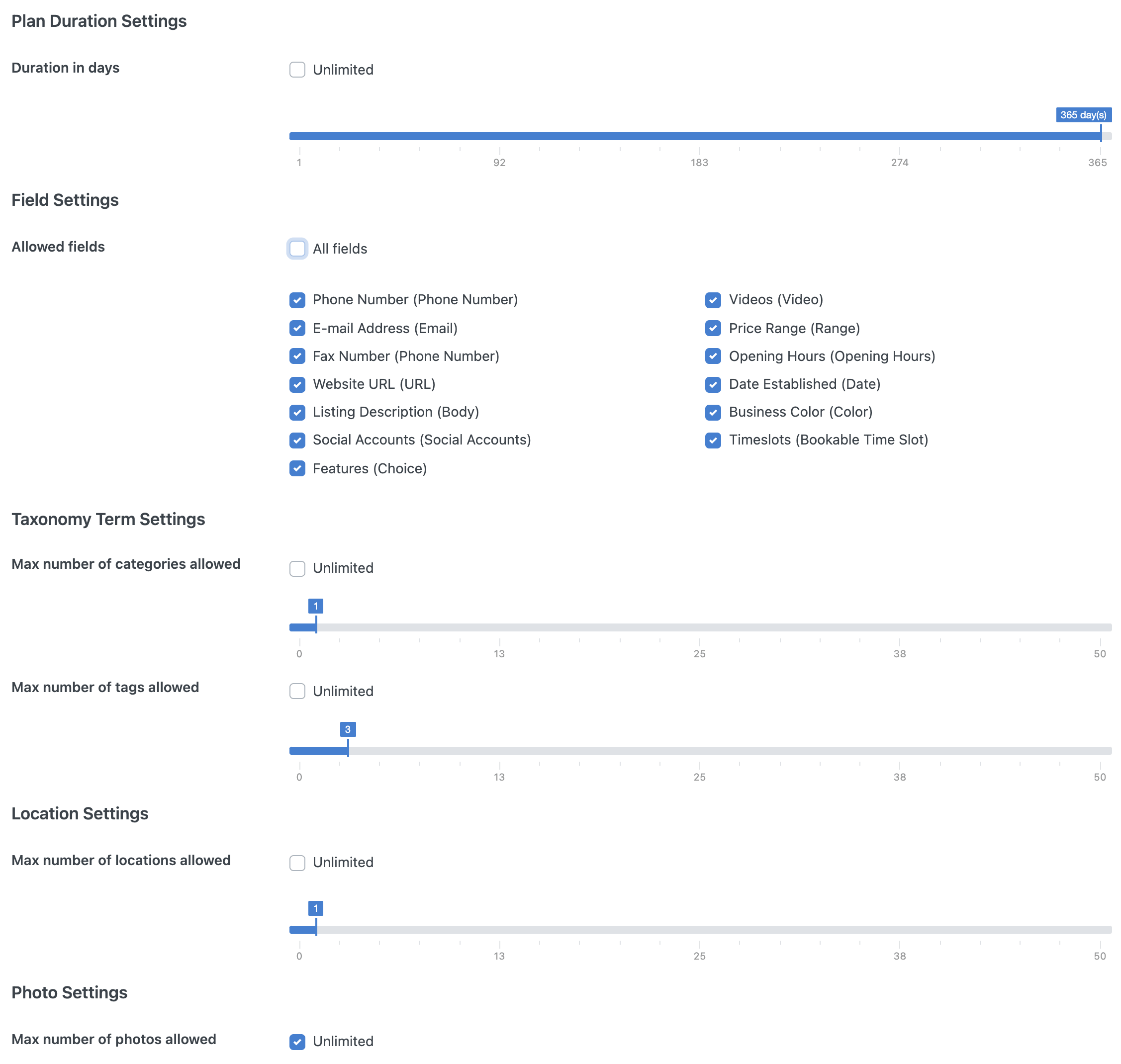
Plan Duration Settings
- Duration in days - Set the length of time in days the payment plan is associated with listings. If you wish to use the prorated discount feature, you should define a limited duration.
Field Settings
- Allowed fields - Select the fields enabled for each listing.
Taxonomy Term Settings
Max number of categories allowed - Select the maximum number of categories each listing can be associated with.
Max number of tags allowed - Select the maximum number of tags each listing can be associated with.
Location Settings
- Max number of locations allowed - Select the maximum number of locations each listing can be associated with.
Photo Settings
- Max number of photos allowed - Select the maximum number of photos that can be uploaded for each listing.
Reviews
- Enable reviews - Whether to allow users to submit reviews for each listing.
Contact Form Settings
Enable contact form - Whether to allow users to send messages to listing authors through a Contact Us form.
Contact form recipients - Select email addresses to which messages are sent. If you have added Email type custom fields to listings (see Adding and Managing Fields), those fields can also be selected here.
Press Publish to save.
Adding a Subscription plan
Follow steps 1-3 for adding a Base plan described above.
Select Subscription plan for Plan type and enter the Price.
Select Recurrence type and enter the Recurrence interval. For example, select Monthly and enter 3 to charge users every 3 months.
Optionally, enter a Description and specify the Display order. The display order setting is used to sort payment plans on the add listing page in the frontend.
Configure the features that will be enabled for listings associated with the payment plan. The features you can configure here are exactly the same as those of a Base plan. For details on each feature, see Adding a Base plan.
Press Publish to save.
Adding an Add-on plan
Follow steps 1-3 for adding a Base plan described above.
Select Add-on plan for Plan type and enter the Price.
Optionally, enter a Description and specify the Display order. The display order setting is used to sort payment plans on the add listing page in the frontend.
Most of the features available by default are similar to those available for Base plans. Below are some options available only for add-on plans.
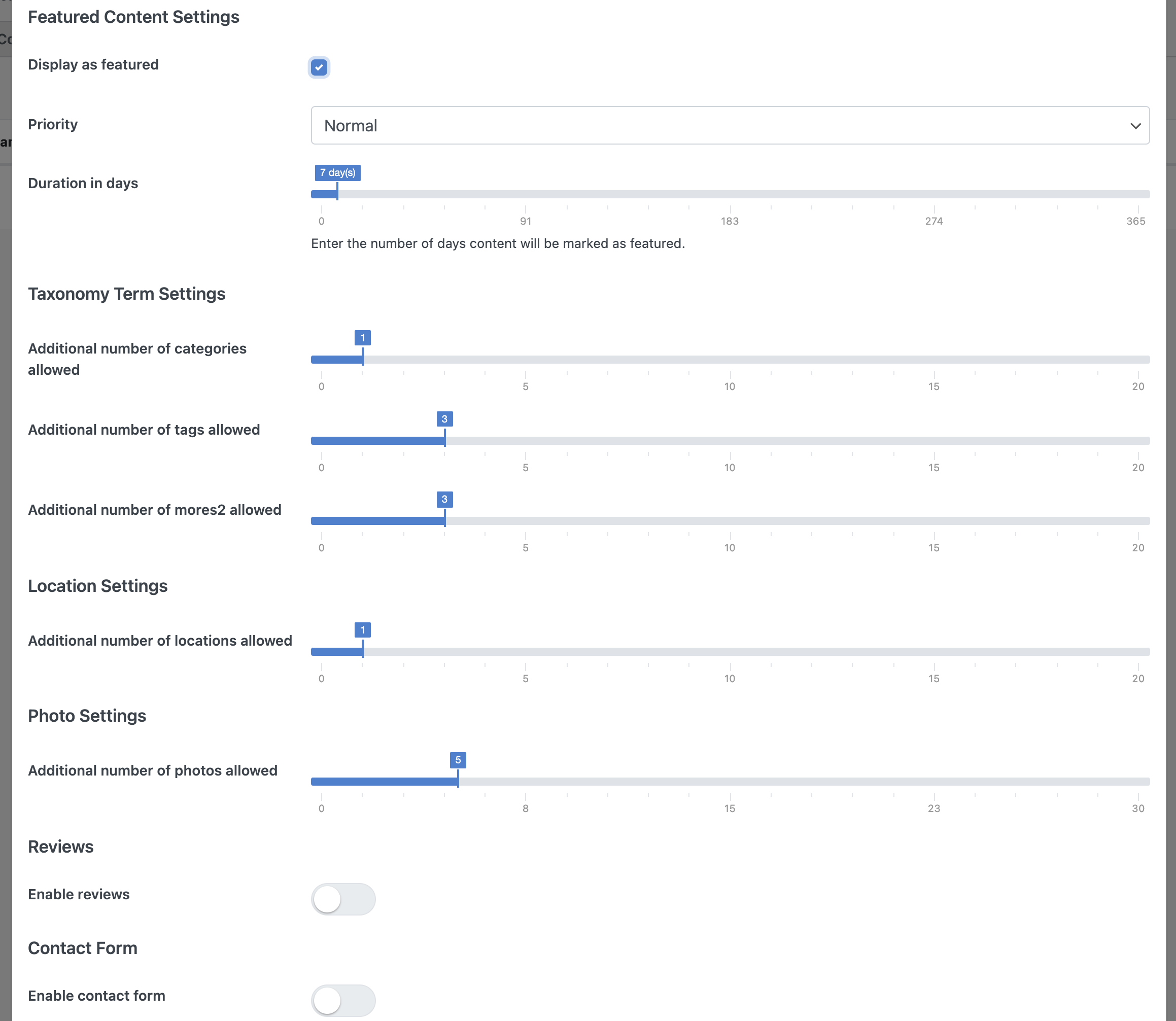
Featured Content Settings
Display as featured - Whether to mark listings as featured. Featured listings can be displayed above other non-featured listings and/or highlighted to make them stand out, or can be displayed separately, for example using custom views.
Priority - When multiple featured listings are displayed and sorted by featured listings first, those with higher priority are displayed above those with lower priorities.
Duration in days - Enter the number of days listings will be marked as featured.
Press Publish to save.
[WooCommerce] Adding payment plans
If you are using the WooCommerce payment component, follow the steps below to create payment plans.
[WooCommerce] Adding a Base plan
Log in to your website if you are not already logged in, and go to the WordPress administration dashboard.
Select Products -> Add New from the side menu.
Enter the name of your payment plan into the text field labeled Product name (required). Optionally, enter the description of your payment plan into the textarea field under the product name field.
Select the Directory - Listing (Base plan) product type option from the dropdown menu in the Product Data panel.
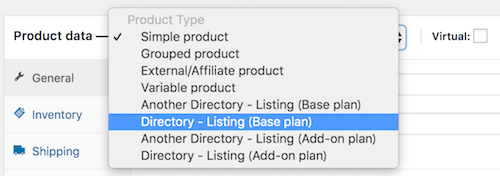
In the General tab, enter the Regular price field and optionally the Sale Price field if you wish to sell the payment plan at a discounted price.
In the Plan Features tab, configure the features that will be enabled for listings associated with this base plan.
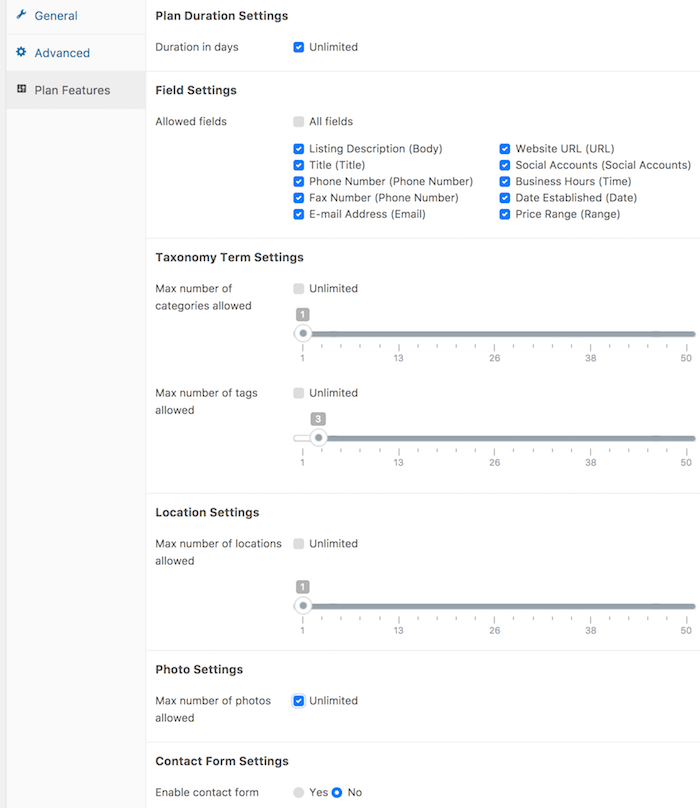
See Adding a Base plan above for details on each feature.
Press Publish to add the base payment plan as a WooCommerce product.
[WooCommerce] Adding a Subscription plan
Make sure the WooCommerce Subscriptions plugin is already installed and activated.
Follow steps 1-3 for adding a Base plan described above.
Select the Directory - Listing (Subscription plan) product type from the dropdown menu in the Product Data panel.
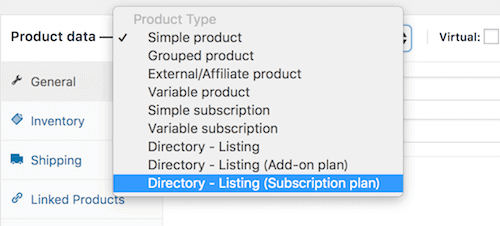
If you do not see the subscription payment plan option in the dropdown, try clearing the cache from Directories -> System -> Tools using the Clear cache tool.
In the General tab, enter the Subscription price field and optionally the Sale Price field if you wish to sell the payment plan at a discounted price.

You can charge renewal payments using a billing period of daily, weekly, monthly, or annually, and at any interval between 1 and 6 (inclusive).
The Expire after setting allows you to end a subscription after a predetermined amount of time. Subscription plans with this setting set to Never expire can renew indefinitely as long as renewal payments are successful.
You can add a Free trial period to the beginning of a subscription. This period is added to any length you set for the subscription. For example, if you create a subscription of $5 per month for 6 months with a 1-month free trial period, the subscription will expire after 7 months.
In the Plan Features tab, select or enter features that should be applied to listings when this subscription plan is purchased. The features you can configure here are exactly the same as those of a Base plan. For details on each feature, see Adding a Base plan.
Press Publish to add the subscription payment plan as a WooCommerce product.
[WooCommerce] Adding an Add-on plan
Follow steps 1-3 for adding a Base plan described above.
Select the Directory - Listing (Add-on plan) product type from the dropdown menu in the Product Data panel.
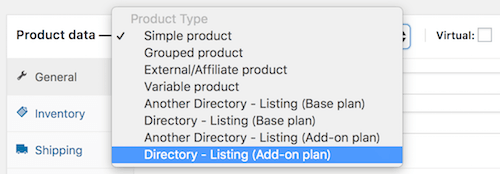
In the General tab, enter the Regular price field and optionally the Sale Price field if you wish to sell the payment plan at a discounted price.
In the Plan Features tab, select or enter additional features that should be applied to listings when this add-on plan is purchased.
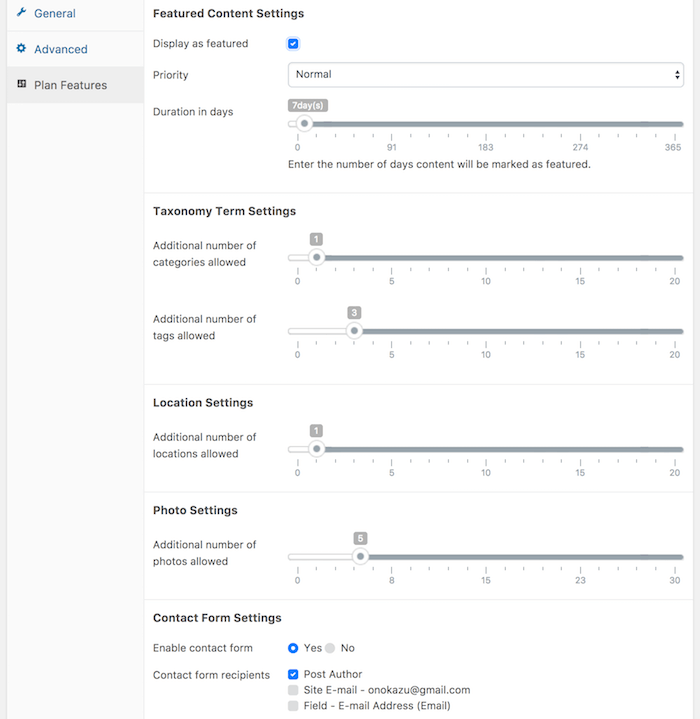
Most of the features available by default are similar to those available for Base plans. See step 4 of Adding an Add-on plan above for details on some options available only for add-on plans.
Press Publish to add the add-on payment plan as a WooCommerce product.
Additional settings
You can find additional payment settings under Directories -> Settings -> Payment.
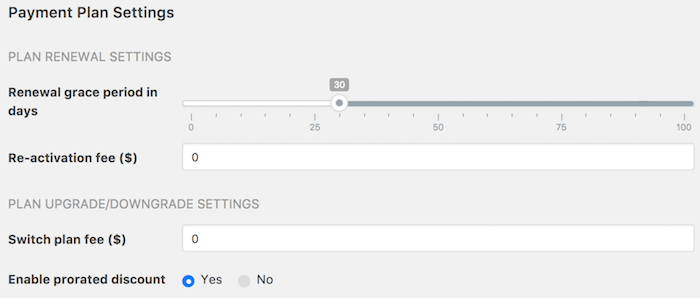
Action after payment plan expiration - Select what action to take for items after payment plan expiration (including renewal grace period), which is processed by WordPress CRON.
Deactivate - Mark items as deactivated (status is set to draft) and hide them from public view. Authors can reactivate items from the frontend dashboard by re-purchasing the same payment plan or purchasing a new payment plan.
Un-assign payment plan and author - Un-assign the payment plan so that payment plan-specific features are removed. Default features are then applied to the items. Authors are unassigned from the items, so the items become claimable by other users.
Un-assign payment plan - Un-assign the payment plan so that payment plan-specific features are removed. Default features are then applied to the items. Authors remain assigned to the items.
Trash - Un-assign the payment plan and move items to trash. Authors remain assigned to the items.
None - Do nothing. Not recommended unless necessary.
Add "No payment plan" option - Whether to add a "No payment plan" option to the payment plan selection form. When the user selects this option, they will go through the normal submission process and the listing submitted will have no base plan assigned.
Display pricing table - Whether to display a pricing table in the first step of the submission page.
Renewal period in days - Specify the number of days listing authors are allowed to renew their listings before expiration.
Renewal grace period in days - Specify the number of days listing authors are allowed to renew their listings after expiration.
Re-activation fee - Enter the amount of the fee to charge listing authors for re-activating their deactivated listings.
Switch plan fee - Enter the amount of the fee to charge listing authors for upgrading or downgrading the current base plan.
Enable prorated discount - Whether to deduct the fee paid for the remaining period of the current base plan from the total amount when purchasing a new base plan.